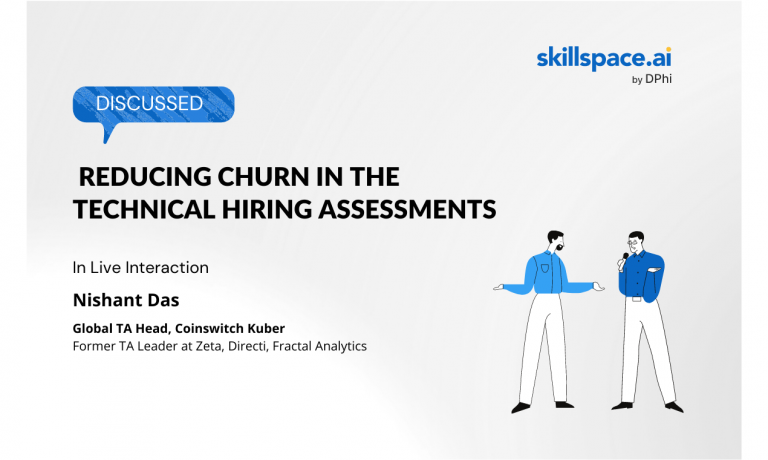Reducing Churn in the Technical Hiring Assessments

Churn is a significant issue in any business. In the case of a tech hiring pipeline, it is crucial to reduce churn as much as possible because what you’re looking at is a potentially huge cost. Especially in these times where attracting a sought-after candidate to apply for a role is challenging. How can you tackle this problem as a talent acquisition professional or a hiring manager?
In an episode of Hiring Diaries, we hosted Nishant Das and asked this question to him. Currently heading global talent acquisition for India’s largest cryptocurrency exchange. Previously, he was a talent leader at Bank of America, Zeta, Fractal Analytics, and Directi. In most of these cases, his teams have scaled their technical assessments to the magnitude of hundreds of thousands of assessments around a year or so.
Our host, Mudit, asked him the question, and this blog covers his perspective and recommendations on reducing churn at the technical assessments stage.
Host, Mudit Srivastava:
Many recruiters that we speak to share about the challenge of candidate churn. Firstly sourcing the top talent is difficult than earlier, and then there’s a massive churn when you send out assessments to candidates. How do you get more candidates to take these tests? Is there specifically to be done for senior roles?
Guest Speaker, Nishant Das:
These problem statements are so common that it brings a smile automatically. It’s something that we tackle day in and day out. I think there is no absolute solution for this.
One thing that ends up working, at least for senior roles, is bringing the assessments in the second stage instead of the first one. You need to have a conversation with the individual for once. At least once from someone in the interview panel, excluding the recruiter, should share why we’re putting this assessment and its purpose.
It’s important to share the problem statement in advance. There’s nothing wrong in saying that we are trying to arrive at this decision on this element. If you are trying to be kind of fair with respect to your interviewing process, there’s nothing wrong in being transparent, saying that we are trying to arrive at some of these elements and these core competencies.
The interviewing process is basically a simulation process, whether you will be successful in this role that we are kind of hiring for. And as long as we are able to bring in that confidence, it just takes two minutes to kind of bring in the purpose of doing that.
When it comes to something like this, there’s no need to force it. As long as something like this can be defined, I think it should be okay. And then, if it doesn’t work out, we’ll leave it to the function of how they want to decide their format of assessments.
However, generally, it’s a good idea to view this as a human process. At all points in time, there needs to be some level of human intervention in the current process through the problem statement.
I think the other thing is that when we’re doing a large scale assessment, typically that has high volume assessment, it happens at an early stage – typically for data analyst or, or analyst role, or SDE 1 kind of role where some of these things kind of come up.
If it is getting tough to explain to everybody verbally at scale, the bare minimum recruiter should explain the purpose of the assessment. Rather than saying there is an assessment, it’s good to define the purpose of the assessment and the parameters that you’re trying to arrive at and share that in advance. And if you can share it in written form, then there’s nothing really like it! It always helps to be kind of transparent in the process. And I think people who you will end up hiring will value that. So that’s all I can say.
Conclusion
While companies struggle to find the trade-off between good assessment practices and optimal churn rates in the pipeline, communication can always be a catalyzer in the process. We hope this blog post helped you understand a strategy that has worked in the past. You can leverage it while conducting automated technical assessments on Skillspace.ai.
If you’re getting started with your technical assessments journey and would like to connect with our team for a consultative call, you can request one here, and someone from Skillspace.ai will be in touch with you to address your queries. Alternatively, if you’d like access to the platform to try it yourself, you can sign up for a free trial here.
Watch the entire Hiring Diaries episode with Nishant Das from Coinswitch.
In this 1-hour episode of Hiring Diaries with the Talent Leader of India’s largest crypto exchange we discussed several agendas including –
- Role of assessments platform as Growth Lever in Technology Hiring
- Reducing Churn in Technology Hiring Funnels
- Recruiting trends in technology for India Inc in 2022
- Candidate Screening Strategies at Different Scales
- Delivering memorable candidate experiences
Plus much more.
To view the entire episode, visit here – https://skillspace.ai/hiring-diaries-201/